How to plant an annual lavater and take care of a flower?
Summer residents, who devote almost all their time to gardening, are quite suitable for decorating a plot of land: planting this annual and caring for it is so simple that you can do it among other, more important matters.
The one-year lavater is often called three-month - the cycle from sowing to the beginning of flowering is exactly 3 months.
When and how to plant?
The time of sowing seeds is determined by the climatic features of the area and the time required to prepare the plant for flowering - 3 months. The optimal time for sowing seeds of annual lavater in open ground is from March in the south to May in areas of continental climate - in the Urals and Siberia. To get early flowering, they are grown in seedlings, starting sowing in February. One-year-old lavender is often sown before winter - with the establishment of cold weather, so that the seeds wake up with the first warm spring.
Sowing in open ground
Seeds are sown directly to the places of permanent "residence" of the flower. The soil is dug up with a small amount of organic matter, large clods are broken, and leveled.
Lavater can be grown in rows or lush bushes consisting of several plants. In the first case, shallow, up to 1-1.5 cm, grooves are made for sowing. In the second, the seeds are placed in shallow holes, located round. The distance between the seeds depends on the height of the variety selected for planting, but not less than 25 cm.
If the seeds are very small, they can simply be scattered and covered with a centimeter layer of earth. Seedlings are then thinned out to bring them to the desired interval. In this case, preference is given to the strongest sprouts.
In order for the seeds to sprout quickly and amicably, the grooves (holes) are spilled with hot water and slightly compacted the earth in them. When the moisture is absorbed, and the soil has cooled slightly, they spread the seeds, fill them up, lightly ram the earth, water it.
At the risk of recurrent frosts, the crops are covered with transparent polyethylene, which is removed when the seedlings grow up.
For winter sowing, the soil is prepared in advance, a reserve of land is made to fill in the seeds. The planting places are not spilled with hot water, so as not to provoke early awakening of the seeds. They also do without watering the sown seeds, replacing it with peat mulching.
Sowing seedlings
For seedlings, seeds are sown from winter in seedling containers - general or individual. The main thing is that they have drainage holes. Any soil will do - the lavater is "omnivorous". Expanded clay or other drainage material is laid on the bottom of the container, soil is poured, lightly ramming it, the seeds are laid out and filled with them.
In order not to make it difficult to pick the seedlings, seeds are laid out in large containers at a distance of 7-10 cm from each other.
Crops are watered and covered with foil or placed in a transparent bag. They are kept on well-lit warm windowsills or in heated greenhouses.
Regular crop care consists of simple manipulations:
- daily ventilation;
- condensate removal;
- moistening the soil as the top layer dries.
When shoots appear, the film can be removed.
Seedlings are also easy to care for: they need warmth, watering and good lighting.
With a lack of lighting, the seedlings stretch out, they do not have enough strength for full development, which is why they often die. To avoid this, additional lighting is organized. Household lighting fixtures will do.
Seedlings dive at the stage of 2-3 pairs of true leaves, pinching the root by a third.For the first few days, cut seedlings require daily watering, very moderate. After 10 days, they are fed with a weak solution of a complex mineral fertilizer for flowers.
With the onset of steadily warm weather, the seedlings of the Lavater are relocated to a permanent place. It should be well lit, the soil can be any. Prepare it as for sowing seeds. Seedlings are transferred into planting holes, the sizes of which correspond to the size of the earthen clod of seedlings. They fill up the earth, ram and water.
The first 7-10 days, seedlings require daily moderate watering, if there is no rain.
Lavater care in the garden
After planting seedlings in open ground, for the first time, the Lavater will need increased attention. In order for the flower to normally take root in a new place and develop as it is set by nature, in addition to watering, it is necessary to regularly loosen the ground under it and remove weeds. Fully adapted plants are not disturbed by loosening the soil, because a significant part of the roots is located close to the surface of the earth.
Adult flowers are watered once a week, if there is no rainfall for a long time, you can water it more often, but without fanaticism - every 3 days.
They are fed twice a season, on poor soils - three times.
- The first feeding - two weeks after transplanting, with complex mineral fertilizers, diluted in half the concentration.
- The second is brought in when the buds begin to form.
- The third time is fed in mid-August, sprinkling with a nutrient solution on the leaf.
Simultaneously with the first feeding for tall lavaters, supports are installed if they do not grow next to fences or other buildings. At the same time, it is recommended to carry out preventive spraying against rust and then repeat the procedure after 10 days.
A mandatory measure is the removal of faded flowers, and not only to maintain the beauty of the flower garden:
- timely removal of dead flowers stimulates the laying of new flower shoots;
- when moisture gets on the wilted petals, a slimy mass is formed that can destroy the plant;
- this prevents self seeding.
At the end of the season - and the lavatera blooms until the very frost - the bushes are dug up with the roots and disposed of.
Pests and diseases
The most common disease of Lavatera (although it rarely happens) is rust damage. On the underside of the leaves, spots of brown, brown or orange-yellow appear. The affected leaves are cut and burned, the plants are treated with fungicides.
Sometimes a green aphid attack is possible. The stems and young leaves are washed with water and treated with insecticides or folk remedies.
How to collect seeds?
Lavatera is pleasant to gardeners in that the seeds of even hybrid forms inherit the characteristic features of the parent plant. Therefore, the seed for the next year is collected from any annuals you like. The seed pods are fully ripe by September, turning brown. They are carefully cut, opened and seeds are poured out of them. Drying is carried out in a moderately warm dry room with mandatory ventilation. The finished seed material is poured into cloth bags or paper bags, marked and stored until sowing.
The best varieties of annual lavatera
In Russia, lavatera (wild rose) is represented by varieties and hybrids of European and domestic selection. The following varieties are popular among summer residents.
- Beautiful girl - peduncles up to 70 cm high are abundantly covered with flowers of white, deep pink or juicy red. The variety grows quickly, blooms until frost. Grow preferably in seedlings.
- Mont Blanc - snow-white flowers on stems up to 60 cm tall.
- Silver Cap - large, up to 8 cm in diameter, salmon flowers are located on a peduncle about 80 cm high.
- Tanagra - deep red flower corollas will perfectly decorate the borders, since the height of the variety does not exceed 50 cm.
- Sun goddess - variety mixture of tall, up to 110 cm, plants. Flowers up to 6 cm in size delight with a variety of colors.
- Novella - dwarf variety 20-30 cm high with pink flowers. Grown in border plantings, as well as in containers, including on the balconies of city apartments.
- White Sherub - height 35 cm, white flowers. Also suitable for curbs and pots.
In addition to the annual, perennial and biennial species of lavater are grown on summer cottages. Planting methods and caring for them are no different from growing an annual. The only difference is that they are prepared for winter by bending the shoots to the ground and covering them with spruce branches or agrotechnics.
The garden lavater grows quickly and practically without human intervention, transforming the site in front of our eyes: the walls of outbuildings and fences are masked with tall flowers, the paths are decorated with dwarf flowers. An undemanding, long and profusely blooming wild rose will be appreciated by any gardener.
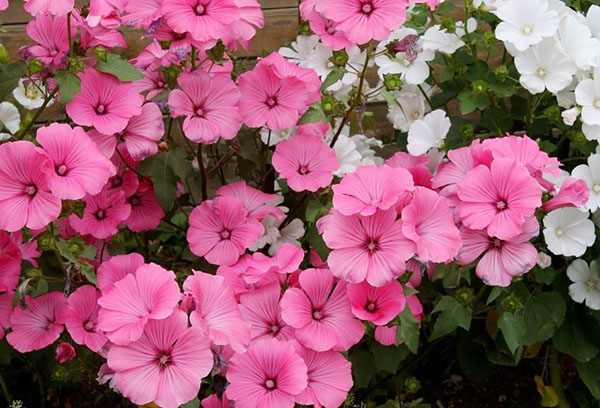
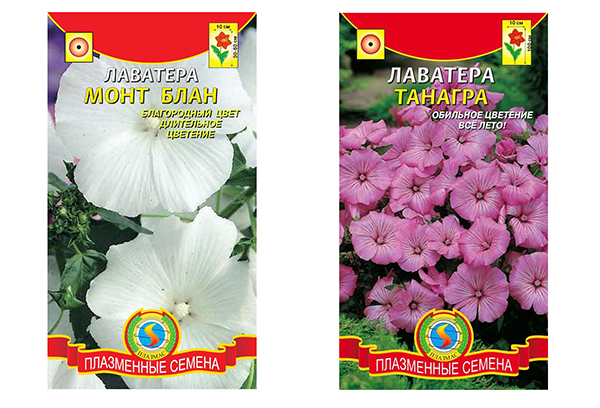
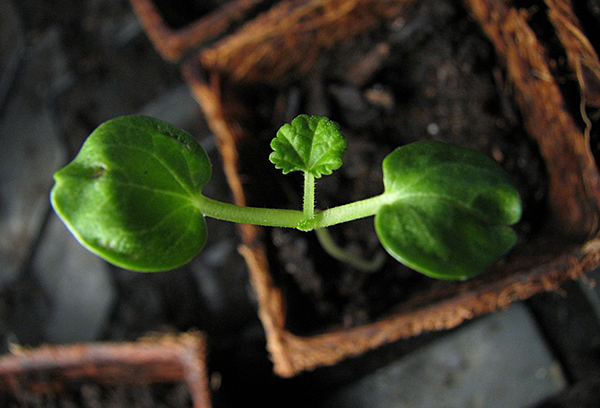
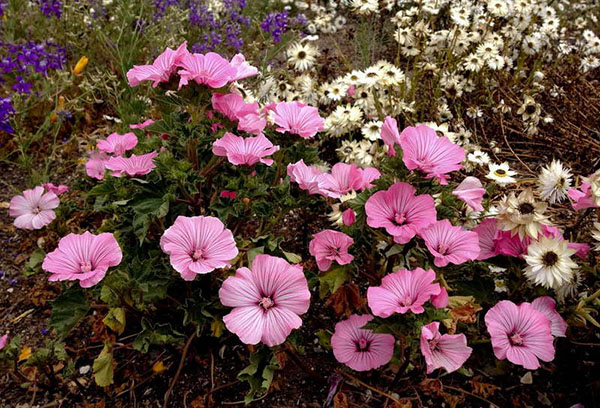
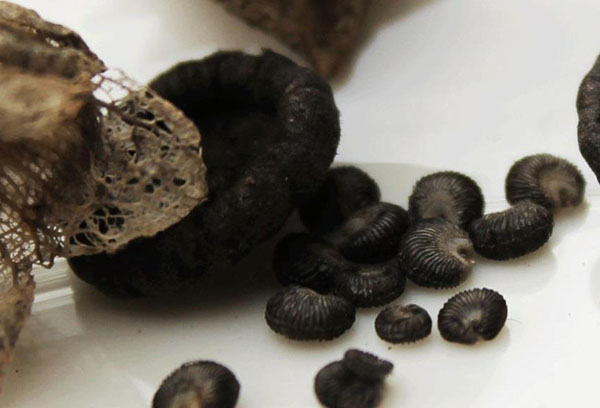
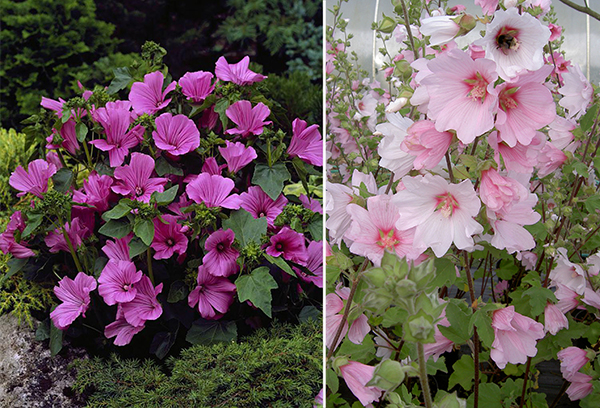
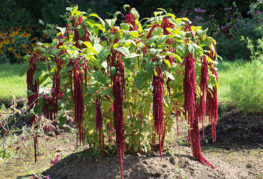
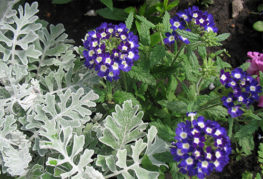
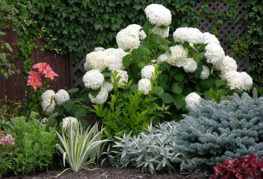


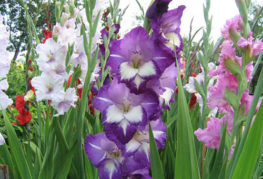
and will be published shortly.